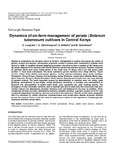| dc.description.abstract | Studies to understand the dynamic nature of farmers’ management of potato and assess the extent of
genetic erosion and farmers’ perceptions of genetic erosion in potato were conducted in Kiambu West
district in 2006. A stratified random sampling procedure was used to draw a sample of 302 farmers for
the study. Majority of the farmers interviewed obtained seeds from informal sources. Farmers identified
29 varieties which were once widely grown in the study area. Of these, only 9 are still grown while
another 11 have been introduced. The most commonly grown varieties were Zangi (69.4%), Tigoni
(41.4%), Thima Thuti (30.8%) and Karuse (20.9%). Twenty cultivars including Amin, Anett, Cardinal,
Feldeslohn, Gituru, Kiraya, Kibururu, Kenya Baraka, Kenya Dhamana, Karora Iguru, Maritta, Mirka, Njae,
Njine, Patrones, Romano, Roslin Bvumbwe, Roslin Gucha, Suzanna and Furaha were the most affected
by genetic erosion. The most important causes for abandonment of varieties were low yields, rapid
greening, susceptibility to late blight, strong dormancy, sensitivity to drought, and susceptibility to
bacterial wilt, susceptibility to potato tuber moth, poor storability and poor cooking quality. The
emergence of new and better varieties, lack of markets and lack of seed were the three most cited nonvarietal
reasons for abandoning varieties. Farmers were not bothered by the loss of varieties. When
comparing varieties currently cultivated to formerly available varieties, a genetic erosion of 31.0% was
computed suggesting that genetic loss has occurred in the study area. Results of this study suggested
that it is necessary to initiate collection, characterization and conservation studies of potato varieties
across the country. There is also the need for awareness creation on the importance of potato genetic
resources and their conservation. | en |
| dc.subject | Conservation, genetic erosion, farmers’ perceptions, Kenya, potato, seed sources, Solanum tuberosum, variety abandonment. | en |

